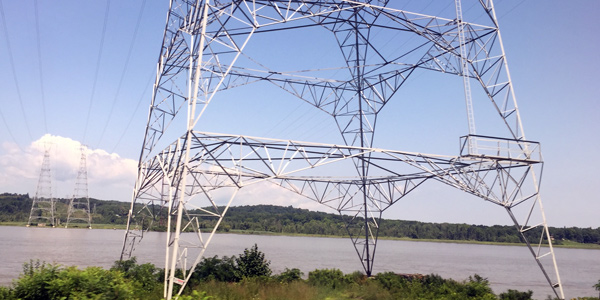RENSSELAER, N.Y. — NYISO’s Business Issues Committee voted Monday to approve a revised charter for the state’s Integrating Public Policy Task Force (IPPTF), the group exploring how to incorporate the cost of CO2 emissions into the ISO’s markets.
Michael DeSocio, NYISO senior manager for market design, highlighted a single sentence added to clarify the task force’s mission: “Incorporating the cost of carbon dioxide into the wholesale energy markets is intended to provide the most efficient means to incentivize carbon abatement from a broad set of electric suppliers, supporting the state’s clean energy policies to reduce electric sector carbon dioxide emissions while continuing to leverage market forces to provide affordable, reliable electricity.”
The IPPTF is being run by NYISO after initially being set up in collaboration with the state’s Department of Public Service. The group next meets at ISO headquarters Aug. 20.
Broader Regional Markets Report
Staff continue work on clarifying the minimum deliverability requirements for external capacity from PJM into NYISO’s Installed Capacity (ICAP) market, Nicole Bouchez, ISO principal economist, highlighted from the monthly Broader Regional Markets report.
At the July 31 Installed Capacity/Market Issues Working Group meeting, the ISO presented its proposed market design to improve the supplemental resource evaluation process for external capacity resources. It will communicate next steps after evaluating stakeholder feedback.
In related matters, Bouchez highlighted that the Independent Power Producers of New York last month filed a complaint asking FERC to direct the ISO to disallow PJM resources from selling ICAP into New York City (Zone J) using certain unforced capacity deliverability rights (UDR) facilities.
Public Service Electric and Gas in May had filed a complaint against Consolidated Edison concerning two transmission lines, B3402 Hudson-to-Farragut (B line) and C3403 Marion-to-Farragut (C line). PSE&G alleged that underwater portions of the lines may have been permanently damaged and should be removed.
On June 6, the ISO filed a protest with FERC indicating that removal of the B and C lines would undermine resilience in both New Jersey and New York and requested that PSE&G’s complaint be denied.
Sub-20-MW Constraint Reliability Margin Values
The BIC approved the ISO’s proposal to apply a sub-20-MW constraint reliability margin (CRM) value to certain facilities where warranted. A CRM is a portion of a transmission facility’s capacity kept in reserve to help meet NERC and other reliability standards. A few facilities use the normal 20-MW CRM under most conditions but also use a larger CRM during periods of higher load, such as the Gowanus Substation in Brooklyn.
David Edelson, manager for operations performance and analysis, said the ISO would base its determination to use a sub-20-MW CRM mainly on the desire to keep CRM values at a level representing no more than 10% of a facility’s rating.
NYISO’s Tariff currently requires use of a minimum value of at least 20 MW for any non-zero CRM value employed in the day-ahead and real-time markets. As the ISO continues to consider inclusion of certain 115-kV facilities with lower thermal ratings (relative to 230-kV and higher facilities) into its dispatch, a 20-MW CRM can often represent a significant percentage of the facility limits.
For instance, many 115-kV facilities have post-contingency limits of 150 MW or lower. A 20-MW CRM represents 13% of the rating for a 150-MW facility.
In megawatt terms, a facility with a 150-MW rating and a 20-MW CRM would be secured in the dispatch using a 130-MW limit. By comparison, a typical 345-kV circuit has a 1,550-MW post-contingency rating with a 20-MW CRM representing only about 1% of the rating.
The ISO will seek Management Committee approval at its next meeting Aug. 29, and by the ISO’s Board of Directors during a special call on the issue in early September, with a FERC filing targeted for the middle of next month.
T&D Manual Revisions
The BIC voted to approve incorporating into the ISO’s Transmission and Dispatching Operations Manual (T&D Manual) an existing technical bulletin on the procedures transmission owners must use to secure their facilities into the Business Management System (BMS) day-ahead and real-time market models.
The information would be located in a new section in the manual and would not substantively differ from the existing guidelines, said Ethan D. Avallone, senior market design specialist.
The committee also approved proposed revisions to Section 3.1.3 of the T&D Manual, specifying that the New York Control Area reserve is monitored through the use of the Reserve Monitor Program; and to Section 4.2.11, regarding procedures when a transmission owner or the Northeast Power Coordinating Council observes or reports significant geomagnetically induced currents.
Distillate Prices Up 40% Y-o-Y
NYISO locational based marginal prices (LBMP) averaged $39.58/MWh in July, up nearly 18% from June and 10% higher than the same month a year ago, Bouchez told the BIC.
Year-to-date monthly energy prices averaged $46.64/MWh in July, a 28% increase a year ago. July’s average sendout was 529 GWh/day, higher than 445 GWh/day in May and 454 GWh/day a year earlier.
Transco Z6 hub natural gas prices averaged $2.87/MMBtu, up about 17% from both June and a year earlier. Distillate prices dropped slightly compared to the previous month but were up 40% year-over-year. Jet Kerosene Gulf Coast and Ultra Low Sulfur No. 2 Diesel NY Harbor averaged $15.05/MMBtu and $14.81/MMBtu, respectively.
Total uplift costs and uplift per megawatt-hour dropped from June, but the ISO’s 44-cent/MWh local reliability share in June came in higher than the previous month’s 18 cents/MWh, while the statewide share dropped from 12cents /MWh to -57 cents/MWh. Thunderstorm alerts (TSAs) accounted for 21 cents/MWh for the month, down from 39 cents/MWh in June. TSAs occur when actual or anticipated severe weather conditions lead the ISO to reduce transmission transfer limits on the UPNY-SENY interface, which often leads to severe congestion.
— Michael Kuser




